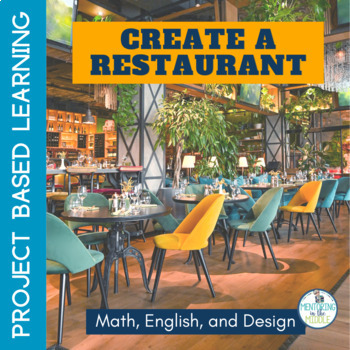Create A Business - Create Your Own Restaurant PBL - Real World Math & ELA PBL
- PDF
What educators are saying
Also included in
- Are you looking for an engaging Project Based Learning activity that allows your students to demonstrate real-world Math and ELA skills? Incorporate more PROJECT BASED LEARNING in your upper elementary or middle school classroom! Each of these projects is aligned with Common Core standards and touPrice $15.97Original Price $21.45Save $5.48
Description
Are you looking for an engaging Project Based Learning activity that allows your students to demonstrate real-world Math and ELA skills? This Create Your Own Restaurant Project blends Math, Writing, and design elements into one fun project!
Students love this PBL where they create their own restaurant around a theme, complete with its history, a menu, and the physical design. Optional Math pages include computing the difference between wholesale and retail costs, ratios and proportions, and taxes and tips.
You can even host a food fair as a final activity where The Sportz Palace, Memery Eatery, Amazin' Glazin’, and other creative eateries serve a sample of one of their foods.
Create Your Own Restaurant includes:
✅ Essential Questions
✅ Objectives and Common Core Standards
✅ Teacher Directions with pictures
✅ Student Directions
✅ Theme brainstorming Pages
✅ Restaurant's History graphic organizers
✅ Restaurant menu graphic organizers
✅ Restaurant design graphic organizers
✅ Teacher directions, examples, and answer keys
✅ Rubrics to use as benchmarks or for feedback
REAL WORLD MATH optional activities:
★ Determine the difference between wholesale and retail costs for restaurant
★ Determine portion size and number of portions served (conversion of ounces to pounds)
★ Compute the difference between wholesale and retail costs
★ Compute tax and tip on a typical bill
★ Use proportions to determine the physical layout of the restaurant
You might also like these other Project Based Learning products
⭐️ Peeps Project Based Learning and STEM Activities
⭐️ Social Studies Project - Create a Country Geography & Map Skills PBL
⭐️ US Geography Plan a Road Trip
⭐️ Christmas Winter Giftwrap Stand
CUSTOMER TIPS:
I greatly appreciate your ⭐️⭐️⭐️⭐️⭐ feedback! And you build points to use towards FREE TPT purchases!
Let's Stay Connected
Click HERE to receive FREE classroom resources as well as ELA tips, book reviews, and ways to blend learning from Mentoring in the Middle.
Questions or Comments?
Feel free to e-mail me at marion@mentoringinthemiddle.com
Earn TpT credits to use for future purchases!
1. After you log in, go to the "My Purchases" page and download this product.
Use it, then go back to the "My Purchases" page. You'll see a "Provide Feedback" button. Click on that, rate the product, and leave a comment. It's that simple!
2. Do you want to be the first to learn about discounts, free and new products? Click on the GREEN STAR next to my logo on my store page to follow me!






